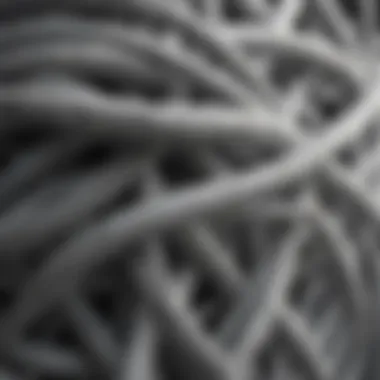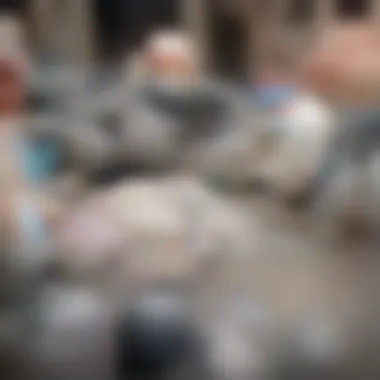The Role of Fiber Glass in Concrete Applications


Intro
Fiberglass has emerged as a critical material in the field of concrete construction. Its integration into concrete applications offers multiple benefits that enhance not only strength but also durability. Understanding the role of fiberglass requires a close examination of its unique properties and various applications. Fiberglass helps improve concrete's overall performance, making it a valuable asset in many construction projects.
Advancements in building materials have pushed professionals to explore alternatives to traditional reinforcement methods, such as steel. This transition highlights the need for innovative solutions capable of addressing contemporary construction challenges.
Research Overview
Summary of Key Findings
Research indicates that fiberglass can significantly enhance the mechanical properties of concrete. The addition of fiberglass reinforcement can lead to:
- Increased tensile strength
- Improved resistance to cracking
- Enhanced durability against environmental factors
- Reduced weight compared to traditional reinforcement methods
The findings also suggest that fiberglass-reinforced concrete could potentially reduce maintenance costs over time.
Background and Context
Concrete is inherently strong in compression but lacks the ability to withstand tension without cracking. Fiberglass, composed of glass fibers in a polymer matrix, provides a viable solution to this limitation. As construction practices evolve, so does the need for materials that offer both strength and flexibility. Fiberglass has proven to be effective in various scenarios, including but not limited to:
- Foundations
- Pavements
- Precast components
The growing emphasis on sustainability and efficiency in construction further underpins the relevance of fiberglass in modern building practices. As we continue to face challenges like climate change and resource limitations, exploring how fiberglass can positively contribute to concrete applications becomes increasingly important.
Methodology
Experimental Design
To assess the benefits of fiberglass in concrete, studies typically utilize controlled experiments. These experiments compare traditional concrete formulations with those incorporating fiberglass. Strength tests, durability assessments, and environmental impact studies form part of the methodology to ensure comprehensive data collection.
Data Collection Techniques
Data collection encompasses both quantitative and qualitative approaches. Common techniques include:
- Compressive strength tests: measuring how much pressure concrete can withstand before failure.
- Flexural tests: evaluating the concrete's ability to resist bending forces.
- Durability assessments: exposing samples to various environmental conditions over time and measuring deterioration.
By aggregating and analyzing this data, researchers can draw conclusions about the long-term performance of fiberglass-reinforced concrete.
"The use of fiberglass in concrete applications not only enhances performance but also broadens the spectrum of design possibilities for modern construction."
End
Understanding the role of fiberglass in concrete applications reveals its potential to transform construction practices. Its advantageous properties and applications signify a shift towards more durable and sustainable building materials. As research advances, ongoing exploration into fiberglass integration will likely yield further insights into optimized construction methodologies.
Prologue to Fiber Glass and Concrete
The integration of fiberglass within concrete applications marks a significant advancement in construction technology. This relationship is not merely about adding a component but enhancing the performance and longevity of concrete structures. Understanding this integration is critical for professionals engaged in modern construction practices, as it brings with it a range of benefits that transform traditional concrete uses.
Definition of Fiber Glass
Fiber glass is a composite material made from fine strands of glass. These strands are woven into a fabric or combined with resins to create a strong and durable product. The unique properties of fiberglass provide excellent tensile strength and resilience, making it a preferred material in various applications, including construction. In concrete, fiberglass serves as a reinforcement agent, improving structural integrity and reducing the risk of cracking. As such, defining fiber glass involves recognizing its composition, properties, and versatility in concrete applications.
Understanding Concrete as a Building Material
Concrete is one of the most widely used building materials globally due to its versatility, strength, and durability. Composed primarily of cement, aggregates (sand and gravel), and water, concrete’s properties can be tailored to meet specific structural requirements. It hardens through a chemical process known as hydration, which allows it to achieve remarkable compressive strength. However, concrete is inherently brittle and can be prone to cracking under stress or adverse conditions.
Thus, the need for additives like fiberglass emerges, as it addresses some of these weaknesses. By incorporating fiberglass, the performance of concrete improves significantly. not only does it enhance the material’s strength under loading, but it also increases its resistance to environmental factors, extending service life and reducing maintenance costs.


Understanding these dynamics is essential for engineers, architects, and builders who aim to utilize modern composite materials to optimize the performance of concrete in today’s demanding construction landscape.
Properties of Fiber Glass
Properties of fiber glass are critical to understand its role in concrete applications. Furthermore, these properties offer innovative solutions for enhancing concrete's performance. Fiber glass is used for its unique attributes, which provide multiple benefits to construction. Knowing these properties helps professionals make informed decisions about materials and their uses in various projects.
Composition of Fiber Glass
Fiber glass is primarily composed of finely woven glass fibers. This fiber is commonly made from silica, alumina, and other compounds. These components contribute to the strength and insulating properties of the material. The combination of strong glass fibers and resin creates a composite material that exhibits substantial durability and resistance to various stresses. In essence, the composition defines its utility in concrete applications.
Mechanical Properties
Tensile Strength
Tensile strength refers to the material's ability to withstand tension without breaking. For fiber glass, this strength measures approximately twice that of steel. The high tensile strength makes it an excellent choice for reinforcing concrete structures. It helps in distributing loads evenly across the material, thus reducing the probability of cracking. This feature enhances the longevity and reliability of the structure.
Flexural Strength
Flexural strength is the capacity of fiber glass to resist deformation under load. This property is essential since concrete often faces bending forces. Fiber glass exhibits superior flexural strength compared to traditional reinforcement materials. This unique characteristic makes it particularly suitable for applications like floors and beams, where bending is common. Its capability to maintain form under stress is a substantial advantage for many construction projects.
Impact Resistance
Impact resistance denotes how well a material can absorb energy and resist sudden forces. Fiber glass has exceptional impact resistance compared to conventional concrete. This means that structures reinforced with fiber glass can withstand shock loads, making them ideal for industrial and infrastructure applications. The enhanced durability ensures that sudden impacts do not lead to catastrophic failures, thereby promoting safety.
Thermal Properties
Thermal Conductivity
Thermal conductivity measures how well a material conducts heat. Fiber glass has low thermal conductivity, which makes it an effective insulator. In concrete applications, this helps in regulating temperature fluctuations. This property is especially useful in climates with extreme temperatures. It minimizes energy costs for heating and cooling, leading to a more efficient structure.
Thermal Expansion Coefficient
The thermal expansion coefficient measures how much a material expands or contracts with temperature changes. Fiber glass has a similar thermal expansion coefficient to concrete, which helps prevent cracking due to temperature variations. When combined in concrete applications, they expand and contract at similar rates. This minimizes stress on the material, enhancing overall stability.
Advantages of Using Fiber Glass in Concrete
The integration of fiber glass in concrete applications presents significant advantages, enhancing the performance and longevity of structures. In this section, we explore these benefits in detail. Understanding these advantages is crucial for architects, engineers, and contractors who aim to innovate and adapt to modern construction demands.
Increased Durability
Fiber glass contributes to the durability of concrete by improving resistance to various environmental factors. Concrete is susceptible to cracking and deterioration over time due to weather extremes, chemical exposure, and mechanical stress. By incorporating fiber glass, manufacturers can enhance these vulnerabilities. The presence of fiber glass reduces shrinkage and cracking, which helps maintain the integrity of the concrete over an extended period.
Moreover, fiber glass exhibits excellent resistance to corrosive agents, making it suitable for applications in aggressive environments. For instance, structures in coastal areas, where salt exposure is a concern, benefit significantly from this improvement. Thus, the application of fiber glass can result in lower maintenance costs and longer service life for concrete structures.
Enhanced Structural Integrity
Another key advantage of utilizing fiber glass is the improved structural integrity of concrete. The inclusion of fiber glass increases the tensile strength of concrete, allowing it to withstand greater loads without failing. This is particularly relevant in high-rise buildings and large infrastructure projects where load-bearing capacity is critical.
Additionally, fiber glass helps in distributing stress more evenly throughout the concrete. This property minimizes the risk of localized failure, creating a more resilient structure overall. Many engineers are turning to fiber glass to ensure that their concrete designs can endure dynamic loads, such as those caused by earthquakes or heavy traffic.
"Fiber glass enables engineers to push the boundaries of design while ensuring safety and reliability in concrete structures."
Lightweight Benefits
The lightweight nature of fiber glass provides an essential advantage in concrete applications. Concrete, while strong, can be heavy and cumbersome. By integrating fiber glass, the overall weight of concrete can be reduced without compromising its strength. This reduction in weight leads to several benefits.
For one, lower weight can decrease the amount of material needed for formwork and support structures. This aspect can lower project costs and speed up construction time. Furthermore, lightweight concrete is advantageous in retrofitting existing structures, allowing for more complex modifications without overloading the original design.
Applications of Fiber Glass Reinforced Concrete


The implementation of fiber glass in concrete is increasingly gaining traction across various fields. This application melds two critical building materials, promoting enhanced performance in specific roles. The positive effects can be seen in both the construction industry and infrastructure projects, along with its benefits for sustainable architecture. Understanding these applications is fundamental for professionals aiming for innovative solutions in contemporary construction.
Construction Industry
Building Facades
Building facades are one significant area where fiber glass reinforced concrete excels. The composite material offers exceptional resistance to environmental elements while maintaining an aesthetically pleasing appearance. This characteristic makes it a popular choice in contemporary architecture, especially in urban settings where durability is paramount.
Its unique feature lies in its lighter weight compared to traditional concrete, which reduces the load on building structures. However, this advantage comes with the necessity of proper installation techniques to ensure optimal performance and longevity. In summary, incorporating fiber glass into building facades presents both aesthetic and practical solutions.
Precast Panels
Precast panels represent another application of fiber glass reinforced concrete that deserves attention. The nature of precasting allows for factory-controlled environments, which enhance quality and consistency. A notable characteristic of precast panels is their versatility; they can be designed for various shapes and sizes to suit specific architectural demands.
This is particularly beneficial when striving for innovative designs while maintaining structural integrity. Yet, the disadvantages include higher upfront costs and logistical challenges associated with transport and assembly on-site. Nonetheless, precast panels continue to be a favored solution in various construction projects due to their efficiency and reliability.
Infrastructure Projects
Bridges
Fiber glass reinforced concrete plays a pivotal role in bridge construction. The material provides strength while remaining lightweight, which is especially essential for long-span bridges. A key characteristic is its resistance to corrosion, making it an excellent option for areas exposed to high moisture and de-icing salts. This durability can lead to overall cost savings in maintenance over the longevity of the structure.
However, there are limitations, such as the specialized knowledge needed for in-situ applications involving fiber glass. It raises the need for trained personnel to maximize the benefits.
Tunnels
Tunnels are another critical project area where fiber glass reinforced concrete shines. Its strength-to-weight ratio allows for reduced excavation and structural support, making construction faster and more efficient. The flexibility of design also offers unique solutions that may adapt to geographical constraints.
However, issues may arise during installation, particularly with water infiltration which needs careful consideration. Thus, while the benefits are compelling, the challenges are necessitating thorough planning and execution.
Sustainable Architecture
In sustainable architecture, fiber glass reinforced concrete is recognized for its efficiency in resource utilization and waste reduction. It helps lower the energy footprint of buildings while providing great structural integrity. Its incorporation into eco-friendly designs signifies a trend towards using innovative materials to balance ecological concerns with functional performance.
As designers and builders push for sustainable solutions, fiber glass reinforced concrete is positioned to meet emerging requirements in construction practices.
In summary, the integration of fiber glass within concrete applications across construction and infrastructure showcases how modern materials can elevate traditional practices.
Production Techniques of Fiber Glass Concrete
Understanding the production techniques of fiber glass concrete is essential for anyone involved in construction and material science. These technqiues not only affect the quality of the final product but also influence the cost and sustainability of projects. Effective production methods ensure that the integration of fiber glass into concrete results in superior structural properties and durability.
Manufacturing Fiber Glass Materials
The manufacturing of fiber glass involves several intricate steps. The basic raw materials include glass fiber, resin, and specific additives that enhance the product’s properties. The first process is the creation of glass fibers, which are made by melting silica sand and other minerals. This molten glass is then extruded through fine holes to form fibers. The fibers are collected and woven into mats or strands.
When it comes to fiber glass used in concrete, the quality of these fibers is crucial. High-quality fibers provide better reinforcement, which translates to improved tensile and flexural strength in concrete applications. Moreover, the choice of resin plays a noteworthy role. Commonly used resins include polyester and epoxy, each offering different performance characteristics. Polyester is often chosen for its cost-effectiveness, while epoxy provides superior adhesion and performance under stress.
Mixing Techniques with Concrete
Mixing fiber glass with concrete is a critical step in the production of fiber glass reinforced concrete (FRPCA). The objective during this phase is to achieve an even distribution of fibers within the concrete mix. This uniformity is essential in maximizing the mechanical benefits offered by fiber glass.
There are various mixing techniques that can be employed. One prominent technique involves dry mixing of fiber glass with cement, sand, and coarse aggregates before adding water. Alternatively, a wet mixing method can also be utilized where the fiber glass is dispersed in the water used for mixing. Depending on the project’s requirements, each technique has its advantages. Dry mixing can be easier to manage in terms of material proportions, while wet mixing often results in a more integrated product.
Regardless of the technique used, attention must be paid to the mixing time and speed. Insufficient mixing can lead to clumping of fibers, leading to inconsistent performance. Likewise, over-mixing can damage the fibers, reducing their efficacy. Thus, laboratory tests are often carried out to optimize mixing conditions for specific applications.
In summary, mastering the production techniques of fiber glass concrete is fundamental for achieving optimal results in construction projects. Understanding how to effectively manufacture fiber glass materials and follow best practices for mixing ensures the viability and success of fiber glass reinforced concrete.


Challenges and Limitations
The incorporation of fiber glass in concrete applications, while beneficial, does not come without its challenges and limitations. It is crucial for stakeholders—such as engineers, architects, and project managers—to understand these aspects to make informed decisions. The challenges in using fiber glass reinforce the necessity of careful planning, assessment of costs, and consideration of environmental conditions.
Cost Considerations
One of the main challenges related to fiber glass in concrete is its cost. Fiberglass reinforced concrete (FRC) tends to be more expensive than traditional concrete due to multiple factors. First, the raw material, fiber glass, is generally pricier than standard aggregates. This can lead to higher upfront costs in projects. Additionally, specialized labor may be required for mixing and applying FRC, which can escalate the overall labor costs.
Budget constraints frequently pose a barrier to the wider adoption of fiber glass in concrete projects. This can deter some construction firms from selecting fiber glass despite its long-term benefits. Moreover, the market for fiber glass is not as extensive as traditional materials, leading to fluctuating prices and availability issues. It is essential to conduct a thorough cost-benefit analysis when considering fiber glass for concrete applications. The ultimate goal should be to balance immediate costs with potential savings from enhanced durability and decreased maintenance in the future.
Performance Under Different Conditions
The performance of fiber glass concrete can vary significantly under different environmental conditions. This variability introduces another layer of complexity when utilizing fiberglass in concrete applications. Factors such as moisture, temperature fluctuations, and exposure to chemicals can impact its longevity and structural integrity.
For example, in highly humid environments, fiber glass may face challenges related to moisture absorption. If not properly sealed, this could weaken the bonding between the fiber glass and the concrete mass, leading to premature degradation. Similarly, extreme temperatures can affect the thermal expansion of both materials differently, potentially leading to cracking or other structural issues.
Moreover, exposure to corrosive chemicals can compromise the fiber glass properties over time. Selecting the right type of fiber glass and resin system is critical to mitigating these risks. Manufacturers often conduct detailed testing on fiberglass products to ascertain their performance in specific conditions. To ensure durability, it is vital to understand the local environmental challenges and consider these factors in the material selection process.
"Understanding the limitations of fiber glass in concrete applications is just as important as recognizing its benefits; awareness ensures better design and application practices."
In summary, while fiber glass offers many advantages, its challenges cannot be disregarded. Careful consideration of cost implications and performance under various environmental conditions is crucial for optimizing its use in concrete applications. Engaging with these challenges will enhance the overall effectiveness and sustainability of projects that incorporate fiberglass.
Future Trends in Fiber Glass Concrete Technology
The future of fiber glass in concrete technology is increasingly relevant as the construction industry seeks to balance performance with sustainability. This section highlights the importance of innovation in material science and sustainability efforts, both of which pave the way for improved applications and efficiencies in fiber glass reinforced concrete.
Innovations in Material Science
Material science is at the forefront of advancements in fiber glass concrete. Researchers are developing new formulations that enhance the bond between fiber glass and concrete, resulting in improved mechanical properties. These innovations often include:
- Advanced Fiber Types: New fiber types are being tested, such as alkali-resistant fibers, which provide better durability against harsh conditions.
- Nanotechnology: The integration of nanoparticles into fiber glass composites is enhancing strength and reducing weight, offering a better performance-to-weight ratio.
- Smart Materials: The development of smart materials that can respond to environmental changes is gaining traction. These materials can adjust their properties based on stress or temperature changes, adding a layer of resilience to structures.
These innovations allow for greater versatility in design and function. Designers can create structures that are not only stronger but also adaptable to different conditions, ultimately extending the lifespan of infrastructure.
Sustainability Efforts
Sustainability is a crucial consideration in the construction sector. The push for eco-friendly materials influences the evolution of fiber glass concrete technology significantly. Key points in this regard include:
- Recycling Initiatives: The increasing focus on recycling fiber glass from old structures is helping to create a circular economy in construction. This reduces waste and the demand for new materials.
- Lower Carbon Footprint: Utilizing fiber glass can lead to lighter structures, which require less energy to transport and install, thereby reducing their overall carbon footprint.
- Sustainable Production Methods: Innovations in production processes are minimizing resource consumption and waste. Manufacturers are now adopting cleaner technologies to reduce their environmental impact.
The alignment of fiber glass technology with sustainability principles not only meets regulatory demands but also addresses the market's growing need for responsible construction practices. As this trend evolves, it is likely that the use of fiber glass in concrete will become even more prevalent in environmentally conscious projects.
"The advancement of fiber glass technology in concrete will be instrumental in shaping future construction paradigms focused on sustainability and efficiency."
In summary, the future trends in fiber glass concrete technology indicate a promising shift towards enhanced performance driven by material science innovations and sustainability efforts. Such advancements are essential in addressing current and future challenges in construction, ensuring the industry can meet its structural needs while prioritizing environmental stewardship.
End
The conclusion ties together the insights discussed throughout the article on fiber glass in concrete applications. This section reflects on the significant contributions fiber glass makes to concrete, particularly in enhancing its durability and structural integrity. Understanding the relevance of these features is essential for professionals involved in construction and engineering fields.
Summary of Findings
In the exploration of fiber glass applications in concrete, several key points emerge:
- Enhanced Durability: Fiber glass significantly increases the lifespan of concrete structures due to its resistance to environmental factors.
- Weight Reduction: Its lightweight characteristics allow for easier handling and installation without compromising strength.
- Versatility in Applications: The material proves valuable in various construction projects, from bridges to building facades.
- Production Techniques: Innovations in manufacturing processes have improved the integration of fiber glass with concrete, enhancing performance metrics.
- Cost-Benefit Analysis: While initial costs may be higher, long-term savings and maintenance reduction justify the investment.
Overall, the findings highlight how fiber glass is not just an adjunct but an integral part of modern concrete applications.
Implications for Future Research
Given the complexity and evolving nature of materials science, future research on fiber glass in concrete holds several promising avenues:
- Innovative Mixtures: Studying new combinations of fiber glass with alternative materials could lead to even higher performance structures.
- Environmental Impact: Assessment of sustainability practices in fiber glass production will be vital as global construction efforts increase.
- Field Studies: Long-term performance evaluations of projects utilizing fiber glass reinforced concrete would provide empirical data needed for wider adoption.
- Recycling and Lifespan: Understanding the end-of-life scenarios for fiber glass in concrete applications is crucial for developing sustainable practices.
Research in these areas can foster advancements in construction technology, leading to safer, more efficient, and environmentally friendly building solutions.







